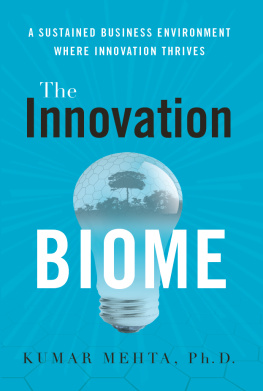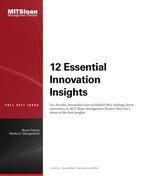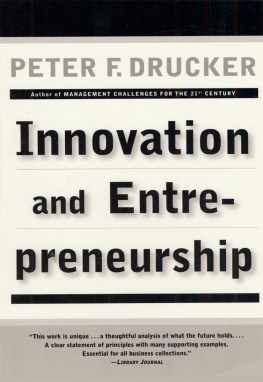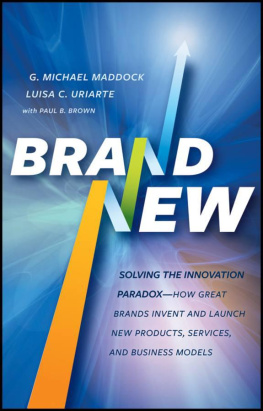Creativity on Demand
Creativity on Demand
The Dilemmas of Innovation in an Accelerated Age
EITAN Y. WILF
The University of Chicago Press
Chicago and London
The University of Chicago Press, Chicago 60637
The University of Chicago Press, Ltd., London
2019 by The University of Chicago
All rights reserved. No part of this book may be used or reproduced in any manner whatsoever without written permission, except in the case of brief quotations in critical articles and reviews. For more information, contact the University of Chicago Press, 1427 E. 60th St., Chicago, IL 60637.
Published 2019
Printed in the United States of America
28 27 26 25 24 23 22 21 20 19 1 2 3 4 5
ISBN-13: 978-0-226-60683-5 (cloth)
ISBN-13: 978-0-226-60697-2 (paper)
ISBN-13: 978-0-226-60702-3 (e-book)
DOI: https://doi.org/10.7208/chicago/9780226607023.001.0001
Library of Congress Cataloging-in-Publication Data
Names: Wilf, Eitan Y., author.
Title: Creativity on demand : the dilemmas of innovation in an accelerated age / Eitan Y. Wilf.
Description: Chicago ; London : The University of Chicago Press, 2019. | Includes bibliographical references and index.
Identifiers: LCCN 2018025832 | ISBN 9780226606835 (cloth : alk. paper) | ISBN 9780226606972 (pbk. : alk. paper) | ISBN 9780226607023 (e-book)
Subjects: LCSH: Creative ability in business. | Corporate culture. | Organizational behavior. | Business anthropology. | Industrial management.
Classification: LCC HD53 .W56 2019 | DDC 658.4/063dc23
LC record available at https://lccn.loc.gov/2018025832

This paper meets the requirements of ANSI/NISO Z39.48-1992 (Permanence of Paper).
To Old La Honda, Page Mill, Tunitas Creek, Kings Mountain, and Alpine Roads
CONTENTS
I would first like to express my deepest thanks to my interlocutors in the field of business innovation who let me into their world and were generous with their time. They were willing to answer my questions regardless of how far removed from their practice these questions were. I hope those of them who end up reading this book will recognize themselves in it, especially the complex, multidetermined, and often contradictory subject positions they occupy.
This book took shape during the 20162017 academic year when I was a fellow at the Center for Advanced Studies in the Behavioral Science at Stanford University (CASBS). This place proved to be ideal not only because of its location at the center of Silicon Valley, the origin site of many of the discourses and practices that this book analyzes, but also because of the nurturing environment it provided me. This environment consisted of CASBSs amazing natural setting, wonderful staff, and other fellows who spent the academic year with me. Among the latter with whom I had countless enriching conversations, I would like to thank Steven Feld, Miyako Inoue, Zephyr Frank, Cate Zaloom, Tara Behrend, Eric Klinenberg, and Margaret Levi. Special thanks are due to Don Brenneisa longtime interlocutorfor making Palo Alto a warm and welcoming place.
I am grateful to the people who engaged with my research when I presented it in the departments of anthropology at the University of California, Santa Cruz and San Diego; Yale University; the University of Amsterdam; the University of Pennsylvania; the Department of Archaeology and Near Eastern Cultures at Tel Aviv University; the Department of Social Anthropology at the University of St. Andrews; the Institute for Social and Cultural Anthropology at the Free University in Berlin; and at the annual meetings of the American Anthropological Association and the Society for the Social Studies of Science. I especially want to acknowledge the helpful feedback given in these venues by Niko Besnier, Don Brenneis, Ilana Gershon, John Haviland, Mette High, Paul Kockelman, Paul Manning, Keith Murphy, Katharina Schramm, Lucy Suchman, Greg Urban, and Kathryn Woolard.
Priya Nelson, my editor at the University of Chicago Press, should be thanked for supporting this project and for giving me invaluable stylistic advice that helped breathe life into an initial version of the manuscript that badly needed it. A number of anonymous reviewers for the press provided crucial feedback that helped significantly improve this book.
Related versions of certain portions of this work have been published elsewhere as follows: portions of and the conclusion first appeared in The Post-it Note Economy: Understanding Post-Fordist Business Innovation through One of Its Key Semiotic Technologies, Current Anthropology 57, no. 6 (2016): 73260; and portions of the introduction were published in The Cool Organization Man: Incorporating Uncertainty from Jazz Music into the Business World, in Modes of Uncertainty: Anthropological Cases, ed. Limor Samimian-Darash and Paul Rabinow (Chicago: University of Chicago Press, 2015), 2945. I am grateful to the editors and reviewers involved in the production of these publications for their feedback on the arguments developed therein.
The research at the center of this book would not have been possible had it not been for the financial support given to me in the form of a Marie Curie Career Integration Grant from the European Research Council, an Individual Research Grant from the Israel Science Foundation, and a Research Grant from the Shane Center at the Hebrew University.
Lastly, I thank Anneke Beerkens for sharing with me her passion for creativity and for modeling it in her thoughts and existence.
The Ubiquity and Ambiguity of Routinized Business Innovation
The Innovators Dilemma
One early September day I finally managed to have a long conversation with David, a business innovation consultant in his midthirties. In 2012, after pursuing an undergraduate degree in physics and a graduate degree in design, David had founded Newfound, a design and innovation consultancy firm, together with two business partners. During the three months before our conversation, I had participated in different innovation workshops organized by Newfound in New York. David was the most verbal and articulate among the innovation consultants I worked with, and I was eager to have a one-on-one conversation with him. However, it was extremely difficult to schedule a meeting because his consultancy practice at the time of my fieldwork required him to travel extensively inside and outside the United States. One afternoon, however, he texted me to say that if I still wanted to interview him, he could make himself available during a two-hour slot the following morning. I immediately responded with Yes! The next morning I arrived at the same shared workspace on the twenty-first floor of a new office building in Manhattans midtown in which Newfounds workshops took place. I found David sitting in a nook next to a floor-to-ceiling window, looking at the busy street below. Upon seeing me, he smiled and without further ado said Go for it. I was not disappointed by our conversation. David responded in detail to each of my questions, taking them in directions that I had not anticipated.
As our conversation drew to a close, I asked him what the participants in the innovation workshops he facilitates find the hardest to learn. The hardest thing of all is finding ways to do this in your job, he immediately responded. Some people come to us and say, I want a job in innovation. And Im like, There are no jobs in innovation! Go be innovative in whatever you do! Davids tone became frustrated. The world deserves people who know something about a thing and then choose to innovate that thing. Like, HR managers should be innovative HR managers. And product managers should innovate methods of product management. People should be innovating in place! He went on to explain that people look at what we do and think of innovation as something separate from the field of knowledge and experience that they have. But, in fact, he argued, you gotta have a minefield of knowledge and experience to innovatepeople, teams, organizations, change management. David paused for a second and added, and innovation processes: so I get to innovate innovation, you know? he laughed. Ive been doing this for seven years, and Im an amateur. So you cannot just show up and do this.












 This paper meets the requirements of ANSI/NISO Z39.48-1992 (Permanence of Paper).
This paper meets the requirements of ANSI/NISO Z39.48-1992 (Permanence of Paper).